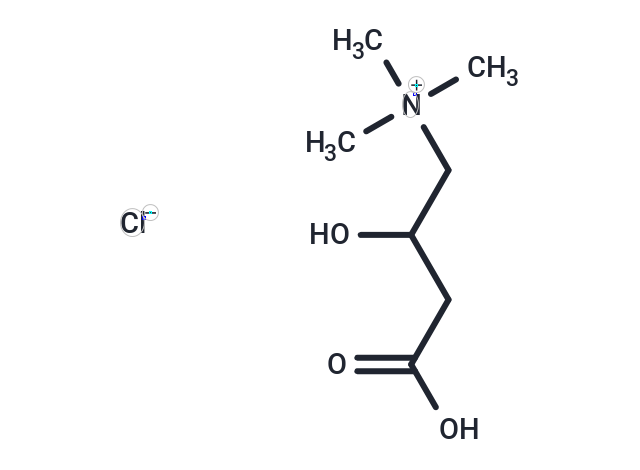Shopping Cart
- Remove All
 Your shopping cart is currently empty
Your shopping cart is currently empty
(±)-Carnitine chloride (Monocamin) is a quaternary ammonium compound biosynthesized from the amino acids lysine and methionine.

| Pack Size | Price | Availability | Quantity |
|---|---|---|---|
| 10 g | $29 | In Stock |
| Description | (±)-Carnitine chloride (Monocamin) is a quaternary ammonium compound biosynthesized from the amino acids lysine and methionine. |
| In vitro | L-carnitine primarily facilitates the translocation of long-chain fatty acids across the inner mitochondrial membrane by transforming acyl-CoA into acyl-carnitine via carnitine palmitoyl transferase (CPT)-I activation. This acyl-carnitine is then converted back into acyl-CoA within the mitochondrial matrix by CPT-II. L-carnitine's introduction enhances palmitoyl-CoA-induced mitochondrial respiration, further accelerated by ADP, showcasing a concentration-dependent effect that reaches saturation at 5 mM L-carnitine[1]. Additionally, L-carnitine pre-treatment enhances Nrf2 nuclear translocation, its DNA binding activity, and heme oxygenase-1 (HO-1) expression in Water2-treated HL7702 cells, providing protection against Water2-induced cell damage through Akt-mediated Nrf2 signaling pathway activation[2]. |
| In vivo | L-carnitine has been shown to modulate the ubiquitin-proteasome pathway and enhance IGF-1 levels in animal studies. Its administration over two weeks can mitigate muscle mass and fiber size reduction in the soleus muscle caused by hindlimb suspension. Additionally, L-carnitine inhibits atrogin-1 mRNA expression, crucial for preventing muscle atrophy. Concurrent L-carnitine treatment also reduces renal fibrosis—associated with lowered plasma TGF-β1 levels—and addresses the enhanced oxidative and inflammatory states observed in L-NAME treated groups, alongside promoting PPAR-γ expression. |
| Kinase Assay | Mitochondria (0.6 mg protein/mL) are incubated in 2.5 mM Hepes (pH7.4) containing 225 mM mannitol, 75 mM sucrose and 100 μM ethylene glycol tetraacetic acid (EGTA) with or without 5 mM L-carnitine at 25°C. To measure oxygen uptake, 10 min after inorganic phosphate (Pi) 4 mM are added, the mitochondria are treated with palmitoyl-CoA (50 μM) and then ADP is added (200 μM). Oligomycin (5 μM) and rotenone (10 μM) are added 3-4 min after the ADP treatment. HPG (0-10 mM), which can specifically inhibit carnitine palmitoyl transferase (CPT)-I activity in the mitochondria, is added in the Hepes medium before incubation of the mitochondria[1]. |
| Synonyms | Monocamin, DL-Carnitine HCl, DL-Carnitine chloride, Bicarnesine |
| Molecular Weight | 197.66 |
| Formula | C7H15NO3·HCl |
| Cas No. | 461-05-2 |
| Smiles | [Cl-].C[N+](C)(C)CC(O)CC(O)=O |
| Relative Density. | no data available |
| Storage | Powder: -20°C for 3 years | In solvent: -80°C for 1 year | Shipping with blue ice/Shipping at ambient temperature. | |||||||||||||||||||||||||||||||||||
| Solubility Information | H2O: 37 mg/mL (187.19 mM), Sonication is recommended. Ethanol: < 1 mg/mL (insoluble or slightly soluble) DMSO: 45 mg/mL (227.66 mM), Sonication is recommended. | |||||||||||||||||||||||||||||||||||
| In Vivo Formulation | 10% DMSO+40% PEG300+5% Tween 80+45% Saline: 2 mg/mL (10.12 mM), Sonication is recommended. Please add the solvents sequentially, clarifying the solution as much as possible before adding the next one. Dissolve by heating and/or sonication if necessary. Working solution is recommended to be prepared and used immediately. The formulation provided above is for reference purposes only. In vivo formulations may vary and should be modified based on specific experimental conditions. | |||||||||||||||||||||||||||||||||||
Solution Preparation Table | ||||||||||||||||||||||||||||||||||||
H2O/DMSO
| ||||||||||||||||||||||||||||||||||||

Copyright © 2015-2025 TargetMol Chemicals Inc. All Rights Reserved.